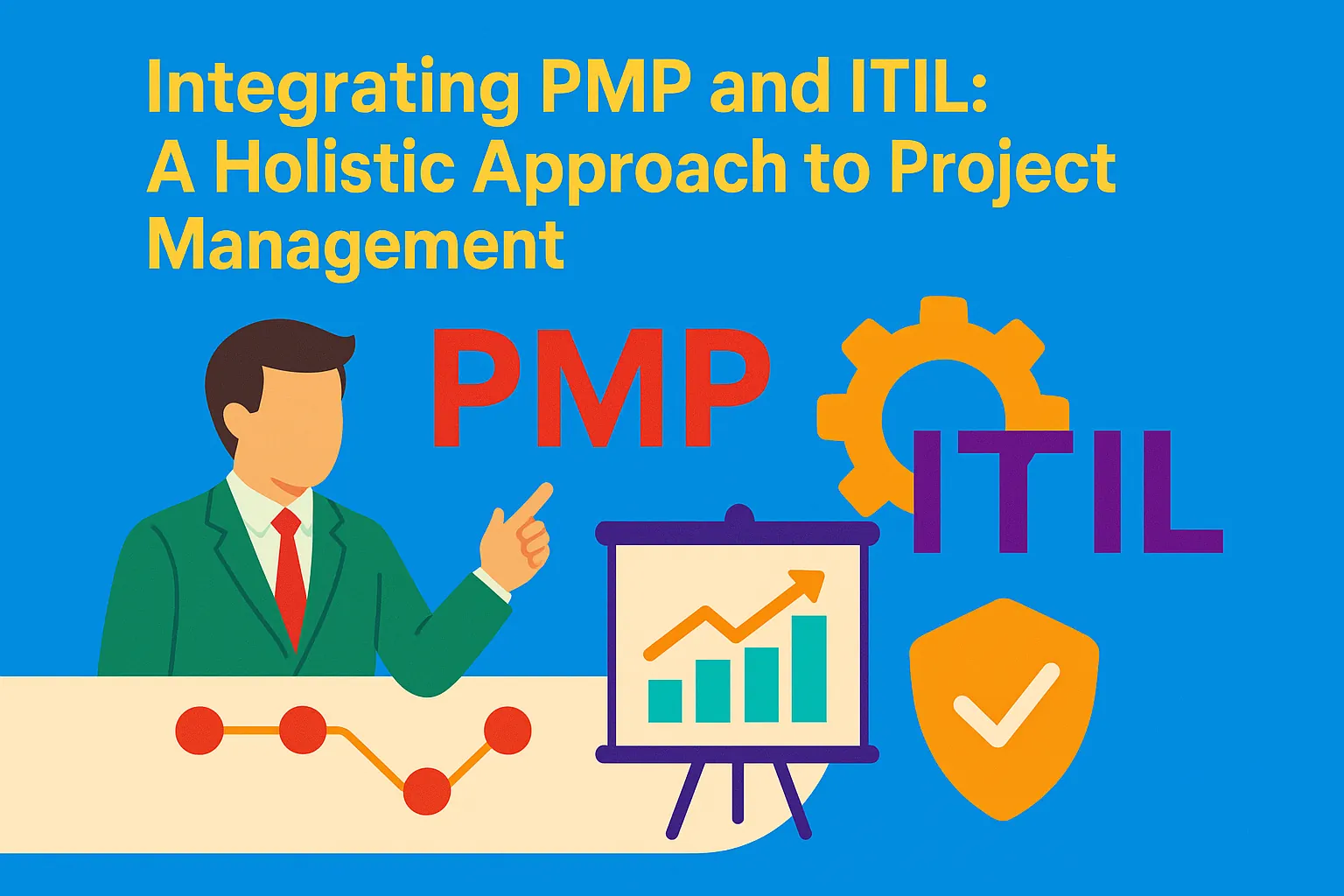Introduction
Two methodologies stand out for their structured approaches and proven effectiveness: Project Management Professional (PMP) and Information Technology Infrastructure Library (ITIL). Understanding these frameworks and their core principles is essential for project management teams and consultants aiming to enhance project outcomes in an increasingly complex business environment.
- Defining PMP: The Project Management Professional (PMP) certification, governed by the Project Management Institute (PMI), is a globally recognized credential that signifies a project manager’s expertise in leading and directing projects. Core principles of PMP include the five process groups—initiating, planning, executing, monitoring and controlling, and closing—and ten knowledge areas that encompass everything from scope management to stakeholder engagement. This structured approach ensures that projects are completed on time, within budget, and to the satisfaction of stakeholders [2][12].
- Defining ITIL: The Information Technology Infrastructure Library (ITIL) is a framework designed to standardize the selection, planning, delivery, and maintenance of IT services within an organization. ITIL emphasizes service management best practices, focusing on aligning IT services with the needs of the business. Its core principles include service value, continual improvement, and a service-oriented mindset, which collectively aim to enhance service delivery and customer satisfaction [1][10].
- Increasing Complexity of Projects: Today’s business environment is characterized by rapid technological advancements, evolving customer expectations, and a growing emphasis on digital transformation. As projects become more complex, integrating various methodologies becomes crucial. The challenges of managing diverse teams, aligning project goals with business objectives, and ensuring effective communication necessitate a more holistic approach to project management [4][10].
- Combining PMP and ITIL: The integration of PMP and ITIL methodologies offers a unique opportunity to leverage the strengths of both frameworks. By combining the structured project management practices of PMP with the service-oriented focus of ITIL, organizations can create a comprehensive management strategy that enhances project delivery and service quality. This synergy not only improves efficiency but also fosters a culture of continuous improvement, ultimately leading to better project outcomes and increased stakeholder satisfaction [4][11].
Understanding PMP and ITIL: Key Differences and Similarities
Both PMP (Project Management Professional) and ITIL (Information Technology Infrastructure Library) serve as essential methodologies, each with its unique focus and application. Understanding their key differences and similarities is crucial for project management teams and consultants looking to integrate these frameworks for enhanced project outcomes.
Primary Focus Areas
PMP Focus Areas:
PMP is a project-oriented methodology that emphasizes the following key areas:
- Scope: Defining and managing all the work required to complete the project successfully.
- Time: Planning and controlling the schedule to ensure timely completion.
- Cost: Estimating, budgeting, and controlling costs to keep the project within the approved budget.
- Quality: Ensuring that the project meets the required standards and stakeholder expectations.
- Resources: Managing human and physical resources effectively.
- Communication: Facilitating effective communication among stakeholders.
- Risk: Identifying, analyzing, and responding to project risks.
- Procurement: Managing the acquisition of goods and services from external sources.
- Stakeholders: Engaging and managing relationships with all parties involved in the project [1][3][4].
ITIL Focus Areas:
In contrast, ITIL is a service-oriented framework that focuses on:
- Service Strategy: Defining the perspective, position, plans, and patterns that a service provider needs to execute to meet an organization’s business outcomes.
- Service Design: Designing new services or changes to existing services to meet business needs.
- Service Transition: Managing the transition of new or changed services into the operational environment.
- Service Operation: Ensuring that services are delivered effectively and efficiently.
- Continual Service Improvement: Ongoing improvement of services and processes based on feedback and performance metrics [5][6][7].
Differences in Approach
The fundamental difference between PMP and ITIL lies in their approach:
- PMP is primarily project-oriented, focusing on the successful completion of projects within defined constraints. It provides a structured methodology for managing projects from initiation to closure, ensuring that all aspects of the project are addressed systematically.
- ITIL, on the other hand, is service-oriented, concentrating on the delivery and management of IT services. It emphasizes the lifecycle of services and the processes involved in delivering value to customers through effective service management [2][8][9].
Similarities
Despite their differences, PMP and ITIL share several similarities that can be leveraged for a holistic approach to project management:
- Stakeholder Engagement: Both methodologies emphasize the importance of engaging stakeholders throughout the project or service lifecycle. Effective communication and collaboration with stakeholders are critical for success in both frameworks.
- Quality Management: Both PMP and ITIL prioritize quality management, ensuring that the outcomes meet the required standards and fulfill stakeholder expectations. This focus on quality helps in delivering successful projects and services [1][5].
By understanding the distinct focus areas, approaches, and shared principles of PMP and ITIL, project management teams can develop strategies to integrate these methodologies effectively. This integration can lead to improved project outcomes, enhanced service delivery, and a more comprehensive approach to managing both projects and services within an organization.
Benefits of Integrating PMP and ITIL
Integrating Project Management Professional (PMP) methodologies with Information Technology Infrastructure Library (ITIL) practices can significantly enhance project outcomes. This combined approach not only aligns projects with business objectives but also fosters a more efficient and effective project management environment. Here are some key benefits of this integration:
- Improved Alignment Between Projects and Business Objectives: By adopting ITIL’s focus on service management alongside PMP’s project management framework, organizations can ensure that their projects are closely aligned with broader business goals. This alignment helps in prioritizing projects that deliver the most value to the organization, thereby enhancing overall strategic effectiveness [2][5].
- Enhanced Risk Management: The integration of ITIL and PMP allows for comprehensive oversight of both service and project management. ITIL’s emphasis on continual service improvement and risk management complements the structured approach of PMP, leading to a more robust framework for identifying, assessing, and mitigating risks throughout the project lifecycle. This holistic view helps in anticipating potential issues and implementing proactive measures [8][9].
- Increased Stakeholder Satisfaction: By delivering projects that not only meet expectations but also adhere to high service quality standards, organizations can significantly boost stakeholder satisfaction. The combined methodologies ensure that stakeholder needs are considered throughout the project, leading to better communication and engagement, which ultimately results in successful project delivery [3][9].
- Streamlined Processes: Integrating PMP and ITIL can lead to more streamlined processes, reducing operational costs and improving resource utilization. The structured approach of PMP, when combined with ITIL’s focus on service delivery and continual improvement, helps in eliminating redundancies and optimizing workflows. This efficiency not only saves time and money but also enhances the overall productivity of project teams [7][8].
Strategies for Integration
Integrating Project Management Professional (PMP) methodologies with the Information Technology Infrastructure Library (ITIL) can significantly enhance project outcomes by leveraging the strengths of both frameworks. Here are actionable strategies for project management teams to effectively combine these methodologies:
- Conduct a Needs Assessment: Begin by evaluating the specific needs of your organization and projects. Identify areas where the integration of PMP and ITIL can add value, such as improving service delivery, enhancing project efficiency, or aligning IT services with business objectives. This assessment will help prioritize integration efforts and ensure they are aligned with organizational goals [5].
- Develop a Common Language and Framework: Establish a shared vocabulary and framework that incorporates key principles from both PMP and ITIL. This common language will facilitate better communication among team members and stakeholders, reducing misunderstandings and fostering collaboration. It is essential to ensure that both methodologies are represented in project documentation and discussions [10].
- Create Cross-Functional Teams: Form teams that include practitioners from both PMP and ITIL backgrounds. This diversity will bring different perspectives and expertise to the table, enabling more comprehensive project planning and execution. Cross-functional teams can help bridge the gap between project management and IT service management, ensuring that both aspects are considered throughout the project lifecycle [11].
- Utilize Tools and Software: Leverage project management tools that support both PMP and ITIL practices. Software solutions like Jira, Vivantio, and Monday.com offer features that cater to both project management and IT service management needs. By using integrated tools, teams can streamline processes, improve collaboration, and enhance visibility into project progress and service delivery [2].
- Implement Training Programs: To ensure that all team members are well-versed in both methodologies, develop and implement training programs. These programs should cover the fundamentals of PMP and ITIL, as well as their integration. Training will empower team members to apply both methodologies effectively, leading to improved project outcomes and service management [4].
By adopting these strategies, project management teams can create a holistic approach that combines the strengths of PMP and ITIL, ultimately leading to more successful project delivery and enhanced IT service management.
Case Studies: Successful Integration Examples
Integrating Project Management Professional (PMP) methodologies with Information Technology Infrastructure Library (ITIL) practices can lead to significant improvements in project outcomes. Here, we explore several case studies from diverse industries that illustrate the successful combination of these two frameworks.
1. NASA: A Model of Integration in Aerospace
NASA has effectively integrated ITIL with PMP to enhance its project management capabilities. By aligning IT service management with project management processes, NASA has achieved:
- Improved Project Delivery Times: The integration allowed for better resource allocation and risk management, leading to timely project completions.
- Enhanced Service Quality: By applying ITIL’s service management principles, NASA improved the quality of its IT services, which directly supported project objectives.
The challenges faced included resistance to change and the need for extensive training. NASA overcame these hurdles by implementing a comprehensive change management strategy and providing ongoing training to staff, ensuring a smooth transition to the integrated approach [2].
2. Wipro Limited: Navigating the Pandemic
During the COVID-19 pandemic, Wipro Limited, a global IT company, utilized ITIL 4 alongside PMP to deliver greater value to its customers. The outcomes of this integration included:
- Increased Agility: The combination of methodologies allowed Wipro to respond quickly to changing client needs, resulting in faster project turnaround times.
- Higher Customer Satisfaction: By focusing on service quality through ITIL, Wipro was able to enhance customer experiences, leading to improved client retention rates.
Wipro faced challenges such as adapting existing processes to fit the new framework. They addressed this by fostering a culture of collaboration and continuous improvement, which facilitated the integration of both methodologies [10].
3. Healthcare Sector: Streamlining Operations
In the healthcare industry, a major hospital network successfully integrated PMP and ITIL to improve its project management processes. The results were notable:
- Reduced Project Delivery Times: By applying PMP principles to healthcare IT projects, the hospital network was able to streamline operations, resulting in quicker implementation of new systems.
- Improved Service Quality: ITIL’s focus on service management helped the hospital enhance patient care services, leading to better health outcomes.
The integration process was not without its challenges. The organization encountered difficulties in aligning the different cultures of project management and IT service management teams. They overcame this by establishing cross-functional teams that encouraged collaboration and shared goals, ultimately leading to a successful integration [2][10].
4. Manufacturing Industry: Enhancing Efficiency
A leading manufacturing company adopted a combined approach of PMP and ITIL to enhance its operational efficiency. The integration yielded several benefits:
- Optimized Resource Utilization: The alignment of project management with IT service management allowed for better tracking and utilization of resources, leading to cost savings.
- Enhanced Project Outcomes: The company reported improved project delivery times and quality of service, which contributed to higher overall productivity.
Challenges included initial skepticism from project managers regarding the value of ITIL. The company addressed this by showcasing early wins from pilot projects, which helped to build trust and demonstrate the benefits of the integrated approach [2][10].
Challenges and Considerations
Integrating Project Management Professional (PMP) methodologies with the Information Technology Infrastructure Library (ITIL) framework can significantly enhance project outcomes. However, this integration is not without its challenges. Below are some common obstacles and considerations that project management teams and consultants should be aware of when attempting to combine these two methodologies.
Common Challenges
- Cultural Resistance: One of the primary challenges in integrating PMP and ITIL is cultural resistance within the organization. Employees may be accustomed to existing processes and may resist changes that come with adopting new methodologies. This resistance can hinder the successful implementation of integrated practices and lead to frustration among team members [11].
- Misalignment of Goals: PMP and ITIL have different focuses; while PMP emphasizes project delivery and management, ITIL is centered around service management and continuous improvement. This difference can lead to misalignment of goals, where project objectives may not fully support ITIL’s service-oriented approach, creating confusion and inefficiencies [10].
- Process Conflicts: The methodologies may have overlapping processes that can lead to conflicts. For instance, the structured phases of PMP may clash with the iterative nature of ITIL processes. This can result in complications during project execution, as teams may struggle to reconcile the differing approaches to project and service management [3][4].
Importance of Leadership Buy-In
Leadership buy-in is crucial for the successful integration of PMP and ITIL. Strong support from senior management can help secure the necessary resources and commitment required for the integration process. Without this backing, teams may find it challenging to navigate the complexities of merging the two methodologies, leading to stalled initiatives and unmet objectives [11]. Leaders should actively communicate the benefits of integration to foster a culture of collaboration and openness to change.
Tips for Overcoming Challenges
- Foster Open Communication: Encourage dialogue among team members to address concerns and clarify the benefits of integrating PMP and ITIL. This can help alleviate cultural resistance and build a shared understanding of the goals and processes involved.
- Align Objectives: Clearly define how the integration of PMP and ITIL will benefit the organization. Establish common goals that reflect both project management and service management perspectives, ensuring that all stakeholders are on the same page.
- Provide Training and Resources: Equip team members with the necessary training and resources to understand both methodologies. This can help bridge knowledge gaps and reduce process conflicts, enabling smoother collaboration between project and service management teams.
- Implement Gradual Changes: Rather than a complete overhaul, consider a phased approach to integration. Start with pilot projects that incorporate elements of both methodologies, allowing teams to adapt gradually and learn from the experience.
- Monitor and Adjust: Continuously assess the integration process and be open to making adjustments as needed. Gathering feedback from team members can provide valuable insights into what is working and what needs improvement, ensuring that the integration remains effective and aligned with organizational goals.
By addressing these challenges and considerations, project management teams can successfully integrate PMP and ITIL, leading to enhanced project outcomes and improved service delivery.
Conclusion
The integration of Project Management Professional (PMP) methodologies with Information Technology Infrastructure Library (ITIL) practices presents a compelling opportunity for organizations to enhance their project outcomes. By combining the structured approach of PMP with the service-oriented focus of ITIL, project teams can achieve a more comprehensive management strategy that addresses both project execution and service delivery.
Benefits of Integration:
- Streamlined Operations: The integration of ITIL with PMP best practices can significantly streamline IT operations, leading to improved service delivery and efficiency. This synergy allows project managers to align project objectives with service management goals, ensuring that projects not only meet their timelines and budgets but also deliver value to stakeholders [2][3].
- Continuous Improvement: PMP emphasizes clear project objectives and resource management, which complements ITIL’s focus on continuous improvement. This alignment fosters an environment where project teams can consistently refine their processes and outcomes, ultimately leading to higher quality deliverables [3][8].
- Enhanced Collaboration: By adopting both methodologies, project teams can facilitate better communication and collaboration across departments. This holistic approach encourages a shared understanding of project goals and service requirements, which is essential for successful project execution [1][7].
As project management professionals, it is crucial to adopt a holistic approach that encompasses both PMP and ITIL methodologies. This integration not only enhances project outcomes but also positions organizations to respond more effectively to changing business needs and technological advancements.
Find out more about Shaun Stoltz https://www.shaunstoltz.com/about/.
This post was written by an AI and reviewed/edited by a human.



